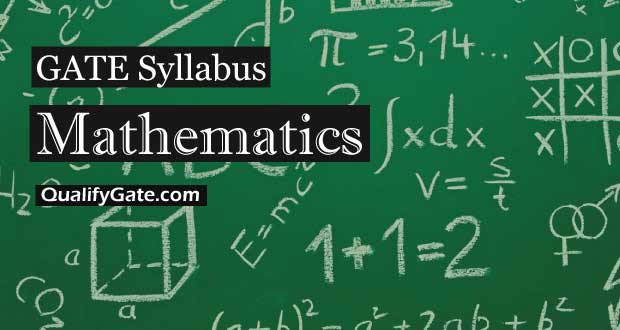PDF download link of GATE 2021 Syllabus for Mathematics (MA) is given in the end of the article.
Syllabus for General Aptitude (GA) (common to all papers)
Calculus: Functions of two or more variables, continuity, directional derivatives, partial derivatives, total derivative, maxima and minima, saddle point, method of Lagrange’s multipliers; Double and Triple integrals and their applications to area, volume and surface area;
Vector Calculus: gradient, divergence and curl, Line integrals and Surface integrals, Green’s theorem, Stokes’ theorem, and Gauss divergence theorem.
Linear Algebra: Finite dimensional vector spaces over real or complex fields; Linear transformations and their matrix representations, rank and nullity; systems of linear equations, characteristic polynomial, eigenvalues and eigenvectors, diagonalization, minimal polynomial, Cayley-Hamilton Theorem, Finite dimensional inner product spaces, Gram-Schmidt orthonormalization process, symmetric, skew-symmetric, Hermitian, skew-Hermitian, normal, orthogonal and unitary matrices; diagonalization by a unitary matrix, Jordan canonical form; bilinear and quadratic forms.
GATE 2021 Syllabus for Mathematics
Real Analysis: Metric spaces, connectedness, compactness, completeness; Sequences and series of functions, uniform convergence, Ascoli-Arzela theorem; Weierstrass approximation theorem; contraction mapping principle, Power series; Differentiation of functions of several variables, Inverse and Implicit function theorems; Lebesgue measure on the real line, measurable functions; Lebesgue integral, Fatou’s lemma, monotone convergence theorem, dominated convergence theorem.
Complex Analysis: Functions of a complex variable: continuity, differentiability, analytic functions, harmonic functions; Complex integration: Cauchy’s integral theorem and formula; Liouville’s theorem, maximum modulus principle, Morera’s theorem; zeros and singularities; Power series, radius of convergence, Taylor’s series and Laurent’s series; Residue theorem and applications for evaluating real integrals; Rouche’s theorem, Argument principle, Schwarz lemma; Conformal mappings, Mobius transformations.
Ordinary Differential equations: First order ordinary differential equations, existence and uniqueness theorems for initial value problems, linear ordinary differential equations of higher order with constant coefficients; Second order linear ordinary differential equations with variable coefficients; Cauchy-Euler equation, method of Laplace transforms for solving ordinary differential equations, series solutions (power series, Frobenius method); Legendre and Bessel functions and their orthogonal properties; Systems of linear first order ordinary differential equations, Sturm’s oscillation and separation theorems, Sturm-Liouville eigenvalue problems, Planar autonomous systems of ordinary differential equations: Stability of stationary points for linear systems with constant coefficients, Linearized stability, Lyapunov functions.
GATE 2021 Syllabus for Mathematics
Algebra: Groups, subgroups, normal subgroups, quotient groups, homomorphisms, automorphisms; cyclic groups, permutation groups, Group action, Sylow’s theorems and their applications; Rings, ideals, prime and maximal ideals, quotient rings, unique factorization domains, Principle ideal domains, Euclidean domains, polynomial rings, Eisenstein’s irreducibility criterion; Fields, finite fields, field extensions, algebraic extensions, algebraically closed fields
Functional Analysis: Normed linear spaces, Banach spaces, Hahn-Banach theorem, open mapping and closed graph theorems, principle of uniform boundedness; Inner-product spaces, Hilbert spaces, orthonormal bases, projection theorem, Riesz representation theorem, spectral theorem for compact self-adjoint operators.
GATE 2021 Syllabus for Mathematics
Numerical Analysis: Systems of linear equations: Direct methods (Gaussian elimination, LU decomposition, Cholesky factorization), Iterative methods (Gauss-Seidel and Jacobi) and their convergence for diagonally dominant coefficient matrices; Numerical solutions of nonlinear equations: bisection method, secant method, Newton-Raphson method, fixed point iteration; Interpolation: Lagrange and Newton forms of interpolating polynomial, Error in polynomial interpolation of a function; Numerical differentiation and error,
Numerical integration: Trapezoidal and Simpson rules, Newton-Cotes integration formulas, composite rules, mathematical errors involved in numerical integration formulae; Numerical solution of initial value problems for ordinary differential equations: Methods of Euler, Runge-Kutta method of order 2.
GATE 2021 Syllabus for Mathematics
Partial Differential Equations: Method of characteristics for first order linear and quasilinear partial differential equations; Second order partial differential equations in two independent variables: classification and canonical forms, method of separation of variables for Laplace equation in Cartesian and polar coordinates, heat and wave equations in one space variable; Wave equation: Cauchy problem and d’Alembert formula, domains of dependence and influence, non-homogeneous wave equation; Heat equation: Cauchy problem; Laplace and Fourier transform methods.
Topology: Basic concepts of topology, bases, subbases, subspace topology, order topology, product topology, quotient topology, metric topology, connectedness, compactness, countability and separation axioms, Urysohn’s Lemma.
Linear Programming: Linear programming models, convex sets, extreme points; Basic feasible solution, graphical method, simplex method, two phase methods, revised simplex method; Infeasible and unbounded linear programming models, alternate optima; Duality theory, weak duality and strong duality; Balanced and unbalanced transportation problems, Initial basic feasible solution of balanced transportation problems (least cost method, north-west corner rule, Vogel’s approximation method); Optimal solution, modified distribution method; Solving assignment problems, Hungarian method.


Please send more shortcuts methods in engg.mechanics,thermal,fluid mechanics, production.